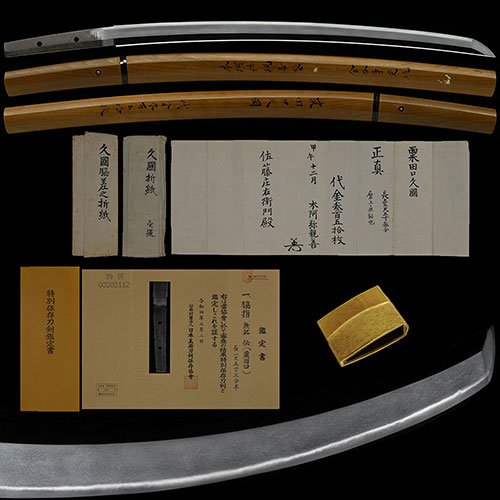
粟田口 脇差Awataguchi Wakizashi
No.273470粟田口 久国 鎌倉初期承久頃 後鳥羽院御番鍛治 本阿弥親善折紙付 究極の梨子地肌に地刃明るく冴える格調高い名品Awataguchi Hisakuni Early Kamakura period, around Joukyu period, Gotobain Gobankaji, Honami-shinzen with Origami, The ultimate Nashijihada, a bright and clear Jiba and elegant masterpiece.
ご成約Sold
- 極めKiwame
- 粟田口Awataguchi
- 登録証Registration
- 奈良県 Nara 昭和26年4月12日 4/12/26(Showa)
- 時代Period
- 鎌倉初期承久頃Early Kamakura period, around Jokyu period
- 法量Size
-
刃長 46.5cm (一尺五寸三分二厘) 反り 1.3cm
元幅 2.6cm 先幅 2.0cm 元重 0.58cm 鎬厚 0.63cm 先重 0.45cm 鋒長 3.0cm 茎長 13.6cm 重量 402gHachou 46.5cm (一尺五寸三分二厘) Sori 1.3cm
Moto-Haba 2.6cm Saki-Haba 2.0cm Moto-Kasane 0.58cm Shinogi-Thikess 0.63cm Saki-Kasane 0.45cm Kissaki-Chou 3.0cm Nakago-Chou 13.6cm Weight 402g - 国Country
- 山城Yamashiro
- 姿Shape
- 鎬造、庵棟、身幅やや細く、反りやや深く、腰反りつき、中鋒。Shinogudukuri, Iorimune, Slightly narrow Mihaba, Koshizori-tsuki, Chu-Kissaki.
- 鍛Kitae
- 小板目肌つみ、板目肌に、小杢目肌交じり、地沸微塵に厚くつき、地景細かく入り、乱れ映り立ち、鉄明るく冴える。Small-Itamehada-tsumi, Itamehada, Mixed Small-Mokumehada, Jinie entered fine and thick, Chikei entered finely, Midare-Utsuritachi, Iron is bright and clear.
- 刃文Hamon
- 細直刃調に、僅かに小乱れ交じり、小足入り、小沸つき、金筋掛り、匂口明るい。Hoso-Suguha-style, Slightly mixed Small-Midare, Small-Ashi entered, Small-Nie entered, Kinsuji-kakari, Nioikuchi is bright.
- 帽子Boushi
- のたれ込んで小丸、先掃きかける。Notarekonde-Komaru, Sakihakikakeru.
- 茎Nakago
- 大磨上、先切、鑢目浅い勝手下り、目釘孔二。Ohsuriage, Sakikiri, Yasurime shallow kattesagari, Mekugiana are two(2).
- ハバキHabaki
- 金着二重。Double Kinkise (Double layered with gold.)
- 説明Drscription
- 粟田口鍛冶は、国頼の子国家を祖とし、その子である国友・久国・国安・国清・有国・国綱の六人兄弟、国儔 の子則国。孫の国吉・国光、さらに国吉の子と伝える藤四郎吉光など、鎌倉時代初期から中期にかけ名工を輩出している。久国は、粟田口六兄弟の四番目で、名を四郎兵衛といい、山城鍛冶の中でも、鍛えと匂口のよさに定評があり、品格高く技量が優れている。重要文化財・重要美術品にも指定されている。この刀は、身幅やや狭く、反りやや深く、腰反りつく優美な小太刀の姿で、小板目肌に小杢目肌つみ、地沸が微塵に厚くつき、地景細かく入る所謂梨子地肌と呼称される明るく冴えた地鉄に乱れ映りが立ち、直刃に、小足入り、小沸よくつき、金筋掛り、匂口明るい格調高い名品である。明治の大鑑定家本阿弥長識の子親善による明治27年に書かれた折紙が附帯する。The Awataguchi blacksmith was founded by Kuniyori's son Kuni, and his sons were six brothers: Kunitomo, Hisakuni, Kuniyasu, Kunikiyo, Arikuni, and Kunitsuna. Kuniyoshi and Kunimitsu, his grandsons, and Toshiro Yoshimitsu, who is said to be Kuniyoshi's son, produced master craftsmen from the early to the middle Kamakura period. Among Yamashiro blacksmiths, it has an established reputation for its forging and good smell, and is of high quality and excellent in skill. Hisakuni is the fourth of the Awataguchi Six Brothers, whose name is Shirobei, and is designated as an important cultural property, Juyo-Bijutsuhin.
This sword has slightly narrow Mihaba, Slightly deep Sori, Koshizoritsuki has an elegant Small-Tachi appearance, Small-Itamehada and Small-Mokumehada-tsumi, Jinie entered fine and thick, Chikei entered finely, The Midare-Utsuri stands in the bright and clear Jigane called Nashijihada, which is finely divided into, Suguha, Small-Ashi entered, Small-Nie entered well, Kinsuji-kakari, Nioikuchi is bright and elegant masterpiece. It is accompanied by Origami, written in 1894 by Shinzen, the son of Hon'ami Choshiki, a great Meiji connoisseur(Daikanteika).


